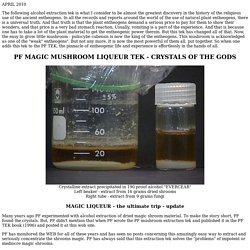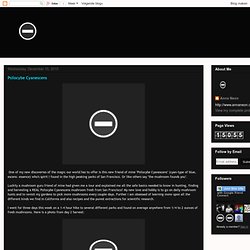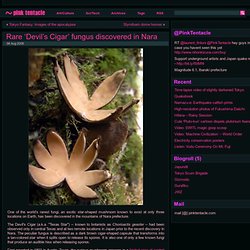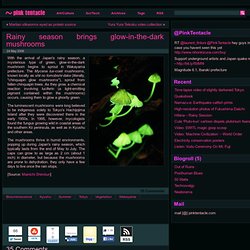Zoom
Trash

Shroomery - Magic Mushrooms (Shrooms) Demystified. Shroomery - Magic Mushrooms (Shrooms) Demystified. Mycology Wiki. Macro Eco Solutions. My Cology. Medica. Mushroom Life Cycle. Shroom Grow. MuShroomAgre. Species. Hello and welcome to the new Mushroom John's "Tales of the Shrooms, a newly rewritten Psilocybian Mushroom Identification Guide.

In this section you will find several pages on how to identify and preserve psilocybian mushrooms for microscopic identification. Also considered are short chapters on their history, their cultivations, various strains of Psilocybe cubensis from around the World as well as a chapter on All Things Amanita/Soma. Fungi of Australia glossary. General Mycology 427. Entheogenic Review. 25-40% Psilocybin crystals - Preparation. This is not my work but it seems that if you follow some of these procedures and the filter the Psilocybin crystals once they pecipitate from solution you would have fairly pure Psilocybinhere is the link THE CRYSTALS OF THE GODS(anonymous experimenter who followed the Professors 190 proof extraction TEK) Suckerfree (Suckerfree)Posted on Wednesday, August 18, 2004 - 07:26 pm: March 5, 2003.

MycoBank in English. CRYSTALS OF THE GODS. The following alcohol extraction tek is what I consider to be almost the greatest discovery in the history of the religious use of the ancient entheogens.

In all the records and reports around the world of the use of natural plant entheogens, there is a universal truth. And that truth is that the plant entheogens demand a serious price to pay for them to show their wonders, and that price is a very bad stomach reaction. Usually, vomiting is a part of the experience. And that is because one has to take a lot of the plant material to get the entheogenic power therein. Fungi Online: An Introduction to the Biology of Fungi - Home Page. STRUCTURE OF A MUSHROOM image.
Structure of a mushroom The mushroom is composed of an underground part (mycelium) and an aboveground, often edible part that is also the reproductive organ. spores. Mushrooms, Fungi, Mycology. Mushroom Pictures & Mushroom Reference. FungiPhoto.com Mushroom Photo Catalog. FUNGI Magazine - The Magazine for Amateur and Professional Mushroom Enthusiasts, Mycophiles and Mycologists. Neuroscientists Probe Psychedelic Psilocybin. Psilocybe Mushrooms. Psilocybe Mushrooms These images appear in the book Psilocybin Mushrooms of the World by Paul Stamets.

They are for informational purposes only and should not be used alone for identification. All photographs are copyrighted by Paul Stamets, all rights reserved, not for re-distribution without written permission. Psilocybe Cyanescens. One of my new discoveries of the magic our world has to offer is this new friend of mine "Psilocybe Cyanescens" (cyan-type of blue, escens- essence) who's spirit I found in the high peaking parks of San Francisco.

Or like others say "the mushroom founds you". Luckily a mushroom guru friend of mine had given me a tour and explained me all the safe basics needed to know in hunting, finding and harvesting a REAL Psilocybe Cyanescens mushroom fresh from San Francisco! My new love and hobby is to go on daily mushroom hunts and to revisit my gardens to pick more mushrooms every couple days.
Further I am obsessed of learning more upon all the different kinds we find in California and also recipes and the purest extractions for scientific research. I went for three days this week on a 1-4 hour hike to several different parks and found on average anywhere from 1/4 to 2 ounces of fresh mushrooms.
Community. Cyber's Cheep CD-Spindle Grow Tek. I orginally did this for fun, It makes a nice simple little grow that is easily hidden.

You will need a 1 pint colonized grain jar to make this work. Things you will need 100 CDR spindle, I think everyone that has a CD burner has a few of these laying around! Which species can be found growing where and when? Panaeolus cinctulus (aka P. subalteatus) This mushroom is listed first because it is the most common and widely distributed psilocybin mushroom.

Found from spring to autumn alone or clustered in lawns, strawpiles, all types of compost, and dung piles in all 50 states and every country in the world. They grow in large numbers on the manure compost piles that are nearby any stable, race track or place where horses are kept. Psilocybe cubensis Found from February to November growing directly from on cow or horse dung, in rich pasture soil, on straw, or on sawdust/dung mixture in Mexico, Cuba, Florida and most other other southern US states and tropical countries.
Panaeolus cyanescens Found in early summer through late autumn scattered, grouped, or clustered on cow dung, or rich soil in tropical areas such as Mexico and Hawaii as well as Florida and other southern states. Rare ‘Devil’s Cigar’ fungus discovered in Nara. One of the world's rarest fungi, an exotic star-shaped mushroom known to exist at only three locations on Earth, has been discovered in the mountains of Nara prefecture.

The Devil's Cigar (a.k.a. "Texas Star") -- known to botanists as Chorioactis geaster -- had been observed only in central Texas and at two remote locations in Japan prior to the recent discovery in Nara. The peculiar fungus is described as a dark brown cigar-shaped capsule that transforms into a tan-colored star when it splits open to release its spores. Rainy season brings glow-in-the-dark mushrooms.
24 May 2006 With the arrival of Japan's rainy season, a mysterious type of green, glow-in-the-dark mushroom begins to sprout in Wakayama prefecture.

The Mycena lux-coeli mushrooms, known locally as shii no tomobishi-dake (literally, "chinquapin glow mushrooms"), sprout from fallen chinquapin trees. As they grow, a chemical reaction involving luciferin (a light-emitting pigment contained within the mushrooms) occurs, causing them to glow a ghostly green. The luminescent mushrooms were long believed to be indigenous solely to Tokyo's Hachijojima Island after they were discovered there in the early 1950s. In 1995, however, mycologists found the fungus growing wild in coastal areas of the southern Kii peninsula, as well as in Kyushu and other areas.
The mushrooms thrive in humid environments, popping up during Japan's rainy season, which typically lasts from the end of May to July. Mush Room.